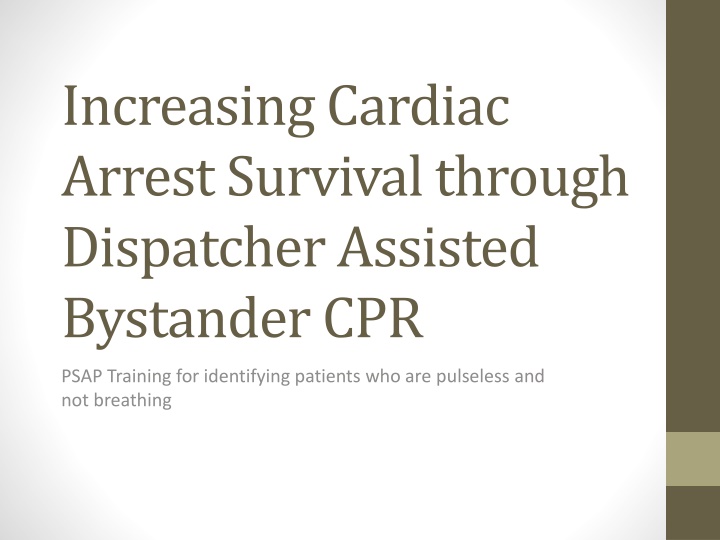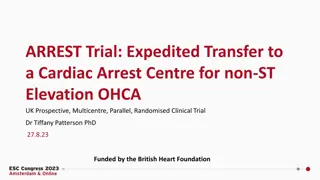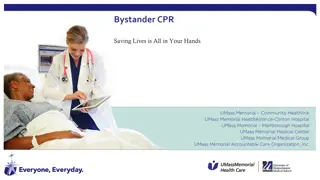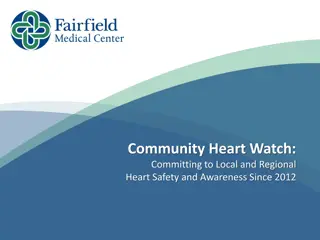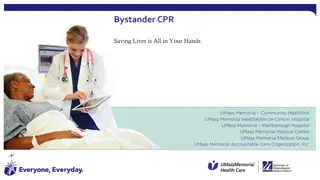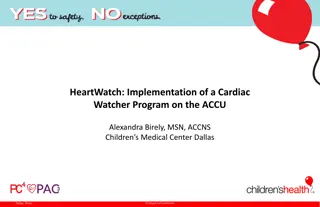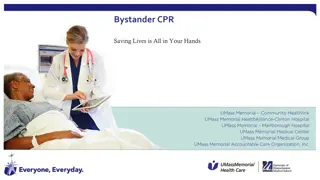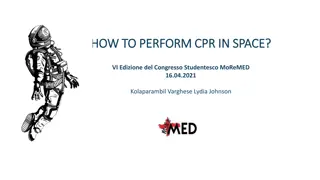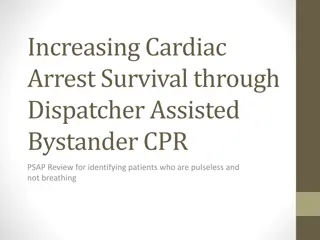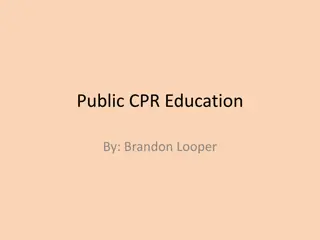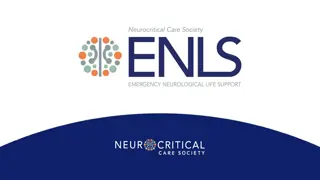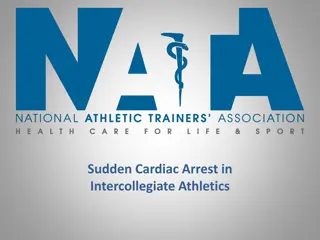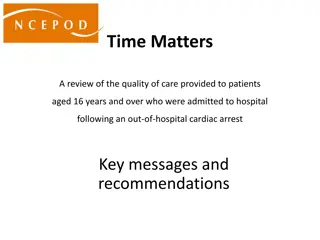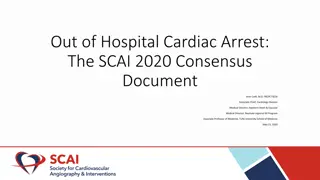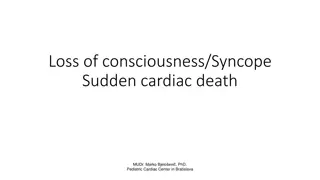Improving Cardiac Arrest Survival Rates Through Dispatcher-Assisted Bystander CPR Training
This project aims to increase cardiac arrest survival rates by training dispatchers to assist bystanders in providing CPR to patients who are pulseless and not breathing. By bringing dispatcher-assisted CPR to Milwaukee County, the goal is to enhance bystander CPR rates and ultimately improve cardiac arrest survival rates.
Download Presentation

Please find below an Image/Link to download the presentation.
The content on the website is provided AS IS for your information and personal use only. It may not be sold, licensed, or shared on other websites without obtaining consent from the author.If you encounter any issues during the download, it is possible that the publisher has removed the file from their server.
You are allowed to download the files provided on this website for personal or commercial use, subject to the condition that they are used lawfully. All files are the property of their respective owners.
The content on the website is provided AS IS for your information and personal use only. It may not be sold, licensed, or shared on other websites without obtaining consent from the author.
E N D
Presentation Transcript
Increasing Cardiac Arrest Survival through Dispatcher Assisted Bystander CPR PSAP Training for identifying patients who are pulseless and not breathing
Disclosure This work is supported by funds from Advancing a Healthier Wisconsin s Change Maker Program
Training Overview Project Vision: where we are and where we want to be Identifying patients who need dispatcher CPR
Project Vision I'm sorry no one saved you. Maggie Stiefvater, The Dream Thieves
To Give Every 9-1-1 Caller the Opportunity to be a First Responder Each year 800 people have an out-of-hospital cardiac arrest in Milwaukee County and 90% die Less than 19% have the benefit of bystander CPR Bringing dispatcher assisted CPR to Milwaukee County will CHANGE: Bystander CPR rates Cardiac arrest survival rates
The Goal Thoughts? What did you notice about these callers? Without the dispatcher what would have happened? How did the dispatcher sound? Did it work?
Links in the Chain of Survival The Metaphor http://www.aedbrands.com/s/1fsY6tZOT0qnEnXDXZ2qtA/Chain-of-Survival.jpg
Milwaukee County Today Directions only in City, W. Allis, Oak Creek Only 19% of the time
Moving Our Focus to the First Two Links Time to first shock 0-8 min 9-12 min 13+ min Time to CPR 64% 41% 30% 0-4 min 49%27%12% 5-8 min N/A 10% 0% 9+min Data on Survival from Witnessed VF Rhythm In King County 2005-2012
Slope of Death 100% 90% 80% 70% Survival 60% 50% 40% 30% 20% 10% 8 1 2 3 5 Minutes 6 7 10 4 9
Where we are today 100% Turn out 90% 80% 70% Defib 60% Dispatch 50% 40% HP-CPR At scene 30% 20% At pt. side 10% 8 1 2 3 5 6 7 10 4 9 Minutes
Where we are going 100% Turn out 90% 80% B-CPR 70% HP-CPR Defib 60% Dispatch 50% At scene 40% 35% At pt. side 30% 20% 10% 8 1 2 3 5 6 7 10 4 9 Minutes
Identifying Patients Who Need CPR: Over the Phone Courage is not the absence of fear, but rather the judgment that something else is more important than fear. Ambrose Redmoon
What are the roadblocks to bystander CPR? A. Cardiac arrest is hard to recognize. B. Rescuers do not have confidence to act. C. Traditional CPR is technically too difficult.
What are the roadblocks to bystander CPR? A. Cardiac arrest is hard to recognize. B. Rescuers do not have confidence to act. C. CPR is technically too difficult. YES YES YES .What to do?
Dispatchers can: Keep It Simple 1. Facilitate rapid identification 2. Instill bystander confidence 3. Coach competent CPR An approach validated by randomized trials Survivall 15% 10% Hands Only Rescue Breathing + Chest Compressions
How Do We Know Seattle - King County experience (1985 - 2012) 50% T-CPR has potential to double proportion who receive CPR 25% Bystander-initiated (No T-CPR)
How Do We Know Seattle - King County experience (1985 - 2012) 50% T-CPR has potential to double proportion who receive CPR 25% Bystander-initiated (No T-CPR)
Cardiac Arrest Signs Sudden, unexpected collapse Unconsciousness, no sign of life Abnormal breathing (gasping) common Brief seizure lack of oxygen to brain
Identifying Cardiac Arrest Is the patient conscious? Is the patient breathing normally? No No Go
All Caller Interrogation Is the patient awake? Yes: Respond as usual (see appropriate chief complaint) No: Go to Step 2 Unsure: Try to wake them up while I wait on the line Is the patient breathing normally? Yes: Respond as usual (see appropriate chief complaint) No: Dispatch ALS/BLS; Transfer to MC EMS Communicator Unknown: Go to Step 3
Agonal Breathing Slow, passive & ineffective breathing. Formal: Abnormal pattern of breathing characterized by shallow, slow (3-4 per minute), irregular inspirations followed by irregular pauses. Chest does not rise and fall NORMALLY in a rhythmic pattern Cause cerebral ischemia, due to extreme hypoxia Caller often mistakes as breathing
Agonal Respirations Is the patient breathing NORMALLY? **Don t be fooled by Agonal respirations Variety of words used by callers: Gasping Snoring Snorting Sighing Gurgling Puffing Light Labored Shallow Audio 1
Two Nos and Go Callers reporting a person unconscious and not breathing normally require ALS response & immediate CPR instructions PSAP will transfer call OK, Sir/Ma am I am sending an ambulance now. I am also transferring you to my partner who will give you more directions Once the MC EMS Communicator answers, PSAP states: This _______ dispatch center. I have a caller reporting an ____(age if known) PNB (give an pertinent details e.g., post drowning). Unit____ has been dispatched.
Common Delays in Delivering CPR Unnecessary questions asked Caller not near patient Omission of breathing normally Deviation from protocols Remember: Studies have shown giving CPR to a person not in cardiac arrest does minimal harm Not giving CPR when someone is in arrest significantly decreases survival Decreasing TIME To CPR is Key!
Process Identify cardiac arrest Two no s and go Ensure responding units are being dispatched Transfer call to EMS Communications Stay on the phone until you can tell the communicator where you are calling from Then you can hang up Send an email notifying xxxx (insert name) that you transferred a call
Questions/ Discussion
